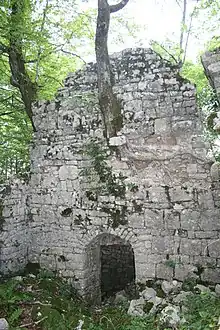| Lashkendari Church | |
|---|---|
 Lashkendari Church | |
| Location | |
| Location | Abkhazia / Georgia |
| Geographic coordinates | 42°49′01″N 41°44′35″E / 42.816944°N 41.743013°E |
| Architecture | |
| Type | Church |
Lashkendari Church (Georgian: ლაშქენდარის ეკლესია, romanized: lashkendaris ek'lesia) is a ruined medieval church on Mount Lashkendar in Abkhazia, an entity in the South Caucasus with a disputed political status.[1] It is located near the small village of Khuhkuni in the Ochamchire Municipality/Tkvarcheli District, some 5-6 km south-east of the town of Tkvarcheli. The site is revered as a holy shrine by both Abkhaz and Georgians.
Description
The church is a complex building, consisting of a main domed edifice to which a smaller church with a semi-circular apse is attached on the north. The whole complex is surrounded by a 100-meter-long protective fence. The two churches communicate through a doorway. The complex can be entered through four doors. The central entrance, located on the south side of the fence, is surmounted with an arch with a Christian cross curved in relief. Above the western door is a bas-relief with two stylized animals facing each other. This piece of arts has its closest parallel to the depiction of two deer on a tympanum above the northern portal of the 7th-century Ateni Sioni Church in eastern Georgia. The remaining two doors are on the northern side of the wall.[2]
The dome of the main church has collapsed. The gate of the church — apparently a later addition — is well-preserved. The church is surrounded by an artificial platform with burials. Archaeological excavations revealed several items, such as: bronze lion figures, candlesticks, different types of ritual items, bearing similarities with other examples of medieval Georgian Christian art.[3] The complex has been variously dated to the period from the 7th to the 11th centuries.[4]
References
- ↑ The political status of Abkhazia is disputed. Having unilaterally declared independence from Georgia in 1992, Abkhazia is formally recognised as an independent state by 5 UN member states (two other states previously recognised it but then withdrew their recognition), while the remainder of the international community recognizes it as as de jure Georgian territory. Georgia continues to claim the area as its own territory, designating it as Russian-occupied territory.
- ↑ "Lashkendari Church". Historical Heritage of Georgia. Vol. 1: Abkhazia. Tbilisi. 2007. pp. 42–43.
{{cite book}}: CS1 maint: location missing publisher (link) - ↑ Lashkendari Church. Historical monuments of Abkhazia — Government of the Autonomous Republic of Abkhazia
- ↑ Endoltseva, E. Yu. (2018). "Храм Лашкендар и абхазо-аланские культурные контакты: перспективы исследования" [The Lashkendar Church and the Alan-Abkhazian Cultural Contacts: Prospects of Studying]. Observatoriya Cultury (in Russian). 15 (3): 298–308. doi:10.25281/2072-3156-2018-15-3-298-308.